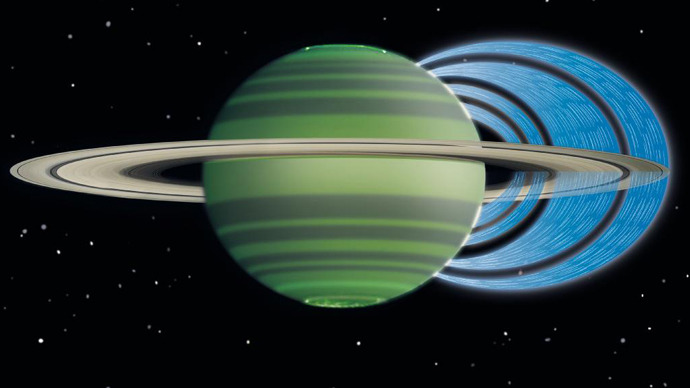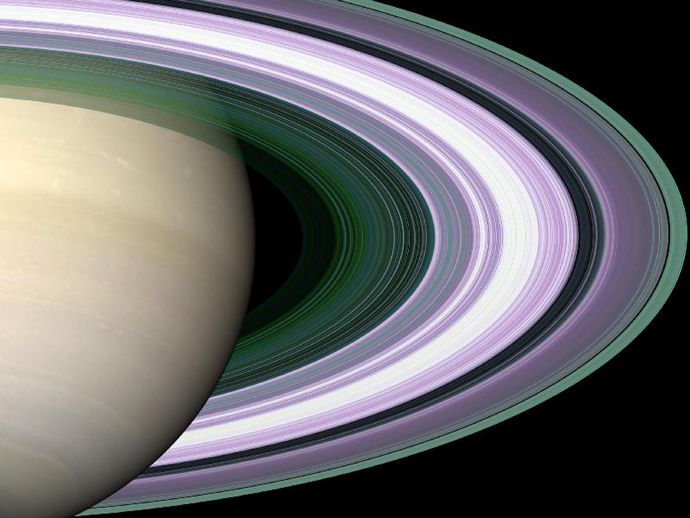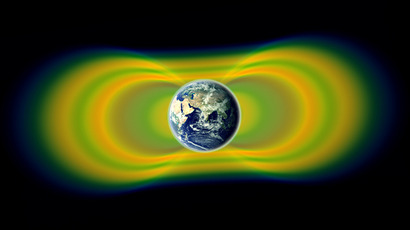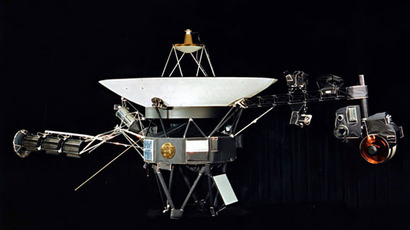Saturn’s rings ‘showering’ on its atmosphere

Saturn's magnetic field is causing ‘rain’ of ionized water particles to shower from the planet’s rings into its atmosphere causing their destruction, a study shows.
“Saturn is the first planet to show significant interaction between its atmosphere and ring system," said James O’Donoghue, the study’s lead author in a news briefing.
The study conducted by researchers from the University of Leicester with observations funded by NASA was published in this week's issue of the journal Nature.
The ring ‘rain’ influences the composition and temperature of parts of the giant gas planet’s upper atmosphere, according to the research.
The astronomers used the Keck Observatory’s 10-meter telescope and its infrared spectrometer to study spectrum emissions from Saturn's upper atmosphere, which is also called the ionosphere.
Emissions of tritium - an isotope of hydrogen that can be used as a proxy for water - were discovered in a wide band across the ionosphere.

The extensive planetary ring system is composed of particles
made almost entirely of water ice, with a trace component of rocky
material. This band extending from about 25° to 60°
latitude is caused by ionized water particles showering from
the rings. These particles can become charged when exposed to a
flow of energetic ionized particles or solar radiation. Saturn's
magnetic field acts as a conduit, channeling these ionized
particles from the rings, along the magnetic field lines and on to
the ionosphere. This leaves the rings’ imprint on the ionosphere,
the dark bands that can be seen using an instrument like that on
Keck, which can split up a wide range of light.
"This pattern implies the transfer of charged particles derived from water from the ring-plane to the ionosphere ... on a global scale, flooding between 30 to 43 per cent of the surface of Saturn's upper atmosphere," the study says.
The first to observe the rings of Saturn in 1610 was Galileo Galilei through his telescope, but was unable to identify them as rings. He thought them to be Saturn’s satellites. Christiaan Huygens in 1655 was the first person to suggest that Saturn was surrounded by a ring. In 1675, Giovanni Domenico Cassini said that Saturn's ring was composed of multiple rings with gaps between them. In 1859 James Clerk Maxwell theorized that the rings were composed of small particles, which was proven later in 1895 through spectroscopic studies carried out by James Keeler of Allegheny Observatory.
The images taken in the early 1980s by NASA's Voyager spacecraft showed two to three dark bands on Saturn. Those bands were not seen again until astronomers observed the planet in near-infrared wavelengths with the Keck’s spectrometer. The magnetic connection between the planet and its rings has been previously suggested. Scientists surmised that water particles could ‘rain down’ from the rings, which can explain the lower-than-expected electron densities in Saturn’s atmosphere, according to the study.
“The main effect of ring rain is that it acts to 'quench' the ionosphere of Saturn. In other words, this rain severely reduces the electron densities in regions in which it falls,” says O’Donoghue in the news briefing.
The ‘rain’ may help scientists establish the origin of Saturn’s vast ring system and its formation.
"We know surprisingly little about Saturn's rings, we're not even sure how old they are," said astronomer Craig O'Neill from Macquarie University, ABC news reports.
Though scientists cannot accurately determine the age of the rings, some features suggest relatively recent origin.
Saturn's rings should only be about 100 million years old "because they would have been disrupted and dispersed by now if they were older," said O'Neill.
However he adds that recent studies indicate they are likely to have formed early in the Solar System's history about 4.5 billion years ago.














